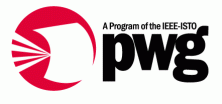
May 27, 2003
Copyright 2003 Printer Working Group, All Rights
Reserved.
XHTML is a trademark of the World Wide
Web Consortium.
In traditional printing environments, clients rely on font downloads when they are not sure a given character is embedded in the printer. As printing moves to small clients, downloading may not be an option and clients have a need to know what characters are available in a given device.
There are many published named character repertoires, and a small client will not know about them all.
[RS] describes the syntax and semantics for the Semantic Model element "RepertoireSupported". The current document describes Best Practices for the use of that element, in order to maximize interoperability between client devices and printers.
The reader of this document should be familiar with the terminology and concepts in [RS].
This section describes the status of this document at the time of its publication. Other documents may supersede this document. The latest status of this document series is maintained at the PWG.
This document informative.
This document is a working draft and only a working draft. It is currently being reviewed by PWG Members but has not been approved. It is not a stable document and may not be used as reference material nor cited as a normative reference from another document.
Public discussion of PWG Character Repertoires takes place on the mailing list: cr@pwg.org. To subscribe send an email to majordomo@pwg.org with the words subscribe cr in the body. You must be subscribed to the mailing list to post there. Please report errors in this document to the editor listed above or on the mailing list.
A list of current PWG Standards and other technical documents can be found at http://www.pwg.org/standards.html.
In order to promote interoperability, this document designates a small number of repertoires as "basic". In this way a print client that only knows the names of the basic repertoires can get useful results.
The repertoires designated as basic are:
A conforming printer should support and advertise a basic repertoire whenever it advertises similar repertoires. For example, any printer advertising any Cyrillic repertoire should also advertise "Unicode_cyrillic". In this way a client that does not recognize a large number of repertoires can still recognize that basic Cyrillic printing is possible on this device.
Printers will often support larger repertoires. If a printer supports a repertoire that is a superset of a basic repertoire, then it should advertise the basic repertoire in addition to the superset. Examples:
A conforming printer should follow these rules:
Printing protocols (outside of this document) specify how a print client learns about the supported repertoires in a printer. Note that supported characters are also constrained by the list of supported character sets, if the printer provides one.
Once it knows, a client may choose to use this knowledge in any of these ways: